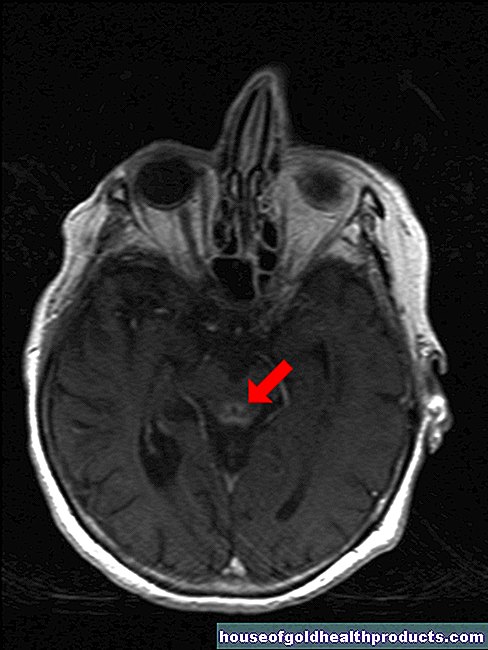Dexamethasone
Updated on All content is checked by medical journalists.Dexamethasone is one of the most important drugs used to suppress the immune system and fight inflammation in the body. The active ingredient is a so-called glucocorticoid ("cortisone"). Dexamethasone is well tolerated with short-term use. Side effects play a role especially with longer and higher-dose treatments. Here you can read everything you need to know about dexamethasone.
This is how dexamethasone works
Dexamethasone is a glucocorticoid ("cortisone"). As such, it has an anti-allergic, anti-inflammatory and depressant effect on the immune system (immunosuppressive or immunosuppressive).
The human body has an efficient defense system that protects the organism from pathogens, pollutants from the environment and degenerated cells. In some diseases, however, this complex system is constantly activated.
The result is inflammation, some of which are directed against your own body and can cause great damage to the tissue.In this case it is usually necessary to suppress the immune system - for example with the active ingredient dexamethasone. It is a highly effective glucocorticoid that inhibits the formation of inflammatory signaling substances (including prostaglandins). At the same time, the formation of new cells of the immune system is reduced. Dexamethasone can stop inflammatory processes and suppress immune reactions.
Uptake, breakdown and excretion
When taken orally, dexamethasone is quickly and almost completely absorbed from the intestines. It takes about an hour and a half to take effect. The active ingredient is mainly broken down in the liver. The breakdown products are excreted via the kidneys.
When is dexamethasone used?
The areas of application (indications) of dexamethasone include:
- inflammatory diseases of the skin (eczema)
- Fluid retention in the brain (cerebral edema)
- Inflammation of the joints (arthritis)
- Prevention of nausea and vomiting as part of cancer treatment (together with other active substances)
- Triggers lung maturity in the unborn child if there is a risk of premature birth between the 24th and 34th week of pregnancy
- severe bronchial asthma
- anaphylactic shock
In addition, dexamethosone is approved in some countries around the world for the treatment of patients with severe COVID-19 infection who need additional oxygen.
This is how dexamethasone is used
Depending on the type of disease, dexamethasone is injected into a vein (intravenous) or a muscle (intramuscular), used as an ointment on the eye or on the skin, or swallowed as a tablet or juice.
In general, glucocorticoids (e.g. dexamethasone tablets) taken orally (via the mouth) should be taken in the morning with or after a meal. This can reduce possible side effects.
The dose of dexamethasone depends on the type and severity of the disease. So four milligrams a day can be enough. In severe, acute cases, the dose can also be increased to up to 100 milligrams per day. Patients with liver problems receive a reduced dose.
Sometimes it makes sense to start dexamethasone treatment with a very high daily dose and then slowly reduce the dose as symptoms improve.
In acute stress (for example in the event of pain, accident or illness), the corticoid requirement can be increased. Then the dose of dexamehtasone may have to be adjusted. Patients should not do this on their own, but only in consultation with the treating doctor! In addition, patients treated with dexamethasone (or another glucocorticoid) should ideally always have a "corticoid ID" with them (so that, for example, in the event of a serious accident, the emergency doctor can find out about the treatment).
What side effects does dexamethasone have?
Dexamethasone can lead to numerous side effects, especially when used for longer and in higher doses.
Side effects that can occur relatively quickly after ingestion include:
- Water retention (edema)
- Disorder of sugar metabolism (diabetogenic effect)
The following dexamethasone side effects can occur, especially after prolonged treatment:
- Stunted growth in children and adolescents
- Immune weakness and the associated higher susceptibility to infections
- Redistribution of fat in the body (Cushing's syndrome)
- Kidney dysfunction
- psychological complaints (including depression, anxiety, irritability, anxiety or sleep disorders)
- Visual disturbances
- increased risk of osteoporosis (bone loss)
- Muscle weakness and tendon discomfort
What should be considered when taking dexamethasone?
Contraindications
If treatment with dexamethasone is necessary, there are no real contraindications. However, in certain situations, dexamethasone should only be used after a strict risk-benefit assessment, such as:
- Vaccinations with live vaccines
- Polio (polio)
- Gastrointestinal ulcers
- osteoporosis
- Risk of intestinal rupture
Interactions
If you take active ingredients to neutralize gastric juice (antacids) at the same time, the effectiveness of dexamethasone may be reduced.
The effects and side effects of dexamethasone can be influenced by taking the following active ingredients at the same time:
- Phenytoin, carbamazepine, and primidone (for epilepsy)
- Ketoconazole and itraconazole (for fungal infections)
Dexamethasone can also affect the effects and side effects of other drugs. Possible interactions should be considered when taking the following active ingredients:
- Cardiac glycosides (e.g. digoxin, digitoxin)
- laxative
- Diabetes drugs (antidiabetic drugs)
- Anti-inflammatory pain relievers (such as acetylsalicylic acid, ibuprofen, or indomethacin)
- Anticholinergics such as solifenacin and darifenacin (for irritable bladder) or atropine (as emergency medication and to dilate the pupil before eye exams)
- Fluoroquinolone antibiotics (such as ciprofloxacin and levofloxacin)
Age restriction
Children and adolescents who are in the growth phase should only take dexamethasone after the attending physician has carefully weighed the benefits and risks. The same applies to older patients who are at high risk of bone loss (osteoporosis).
pregnancy and breast feeding period
The active ingredient dexamethasone may only be taken during pregnancy after a doctor has carefully weighed the benefits and risks. Better tried alternatives during pregnancy are prednisone and prednisolone.
Since there is no documented experience with the use of dexamethasone during breastfeeding, the better investigated active ingredients prednisone and prednisolone are used here as well.
The exclusively local treatment of the eyes, ears or the skin with ointments, creams or drops containing dexamethasone is possible during pregnancy and breastfeeding.
To promote lung maturity in premature babies, the active ingredient betamethasone should be used instead of dexamethasone.
How to get drugs with dexamethasone
Dexamethasone is the strongest active ingredient from the group of glucocorticoids. Medicines containing dexamethasone are therefore only available in Germany, Austria and Switzerland with a prescription from a doctor in the pharmacy.
Some dosage forms available in Germany (e.g. nasal spray, oral solution, juice) are not on the market in Austria and Switzerland.
In Austria there is a combination preparation (dexamethasone with lidocaine) for the treatment and prevention of pain and inflammation after surgery on the urethra.
More interesting facts about dexamethasone
Dexamethasone suppresses the skin's response to allergy tests. If you are being treated with dexamethasone, you should therefore discuss with your doctor before an allergy test whether and when you have to discontinue the active ingredient in order not to falsify the test result.
Tags: elderly care Baby Child fitness





























